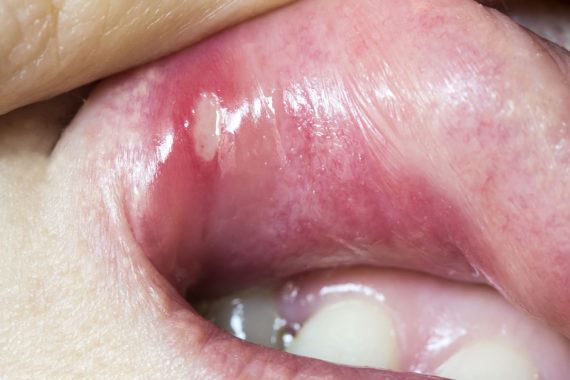What is a Canker Sore?
Canker Sores are painful open sores in the mouth (usually less that 1cm) that look like whitish-yellow areas surrounded by a bright red area. They tend to occur more frequently in women than men, and can occur at any age, but typically between the ages of 10-40.
Canker sores are small, painful mouth sores that occur in about 20% of people. While uncomfortable, the good news is that they are usually not a sign of a more serious oral health condition. Many people are confused by what causes canker sores and how to treat them, however. Dr. Marc Lazare, a renowned general & cosmetic dentist, is always happy to educate his New York City patients on canker sores and what to do about them.
 Aphthous stomatitis
Aphthous stomatitis
Recurrent aphthous stomatitis (aff-thus sto-mah-tye-tis), otherwise known as canker sores, are painful sores that form on the soft tissues inside the mouth.
Although they often occur on the inside of the lips or gums, a canker sore on the tongue or anywhere else inside your mouth is a possibility. These shallow sores are usually yellow, white, or gray in color, with a red border.
Aphthous ulcers are the most common type of oral lesions. While it is not known why some people get canker sores while others do not, women are more likely to be afflicted by the sores than men. Other risk factors include:
- Being between the ages of 10-40
- Family history of repeated stomatitis
- Stress
- Eating spicy foods or acidic food
The sores themselves are benign, and sores or groups of sores tend to form, stay for a few days, then completely recede as though they never existed. However, healing can take 1-2 weeks and recurrent stomatitis can make the mouth sores recur again and again.
Symptoms of canker sores start with a mild tingling or burning sensation, then turn into a bump or group of bumps that ultimately results in open ulceration or a sore red section.
If sore treatment is not performed, canker sores can occasionally cause fever, fatigue, and swollen lymph nodes, or even thrush, infecting the mouth or throat.
Canker Sore vs. Cold Sore: What’s the Difference?
Many patients ask us: are canker sores contagious?
Cold sores, sometimes referred to as fever blisters, are caused by the HSV-1 strain of the herpes simplex virus. HSV-1 is a viral infection that spreads through oral contact with people or objects that carry the virus.
The infection can penetrate something as small as microscopic tears in the inside of the mouth or gums. Its asymptomatic nature keeps many people from even knowing they are infected until cold sores form and causes pain. Cold sores typically form on the lips or other areas outside of the mouth.
Canker sores are different from cold sores in that they’re not contagious or visible, but aphthous ulcers can still make it hurt to do everyday things like eating, tooth brushing, talking, and even smiling or yawning. These sores always occur inside the mouth.
Canker sores tend to happen at the same time as viral infections. This leads to a common misconception that cold sores and canker sores are the same. However, HSV-1 does not cause canker sores, and canker sores can and do happen in the absence of any viruses.
Types Of Aphthous Ulcerations
Minor sores are the most common type of canker sore. They are no more than 3-10 millimeters in diameter and usually last no more than 10-14 days, leaving no scarring.
Major sores are larger and often leave scars. More than 10mm in diameter, major sores are not always circular in shape and take the longest to heal, which could last anywhere from a few days to a few months.
Herpetiform sores are always big groups of small sores, with each sore measuring about 2-3mm. Each group tends to heal without scarring. A group can consist of up to 100 ulcers present at one time.
What Causes Canker Sores?
There is no pinpointed cause of these mouth sores, though they tend to be connected to problems with one’s immune system. Internal causes of a mouth ulcer or ulcerations include, but are not limited to:
- Stress
- An already compromised immune system and autoimmune disorders
- Hormonal imbalances or changes (such as those caused by menstrual periods)
- Food allergies or allergies to certain oral bacteria
- Smoking
- Injuries to the mouth (such as sports accidents)
- A lack of iron, folic acid, and/or vitamin B-12 (cobalamin)
- Generally poor nutrition
- Toothpaste or other oral products containing sodium lauryl sulfate (SLS)
- Oral cancer
- Recent dental work
Is it Common to Get A Canker Sore After Dental Work?
Occasionally, a patient will show evidence of a canker sore after receiving dental treatment. While the exact cause of canker sores is unknown, it is believed that the stress of dental work can potentially lead to irritation.
Canker Sore Relief
Mouth ulcers are painful, and unlike cuts and scrapes, you can’t simply swab alcohol and apply a bandage to mouth sores. So how to get rid of canker sores? There are some methods you can use at home to find relief.
Your first step should be preventing further irritation. Avoid overly hot and/or spicy foods, as well as any acidic or abrasive foods that can hurt your mouth or your swollen gums.
You can also rinse your mouth with a home canker sore remedy to find some relief. The recommended recipe for most of these rinses is to dissolve a teaspoon of any of the following ingredients in ½ cup of warm water. These rinses are a means to relieve pain only and are not a replacement or alternative to canker sore treatment.
Common rinses include:
- Saltwater
- Baking soda
- Antimicrobial rinse
- A solution of milk of magnesia and liquid Benadryl (or another antihistamine)
- Goldenseal
- Infusion of sage and chamomile
- Deglycyrrhizinated licorice (DGL)
- Certain dentist-recommended mouthwashes (like mouthwashes containing steroid dexamethasone or lidocaine)
Following the rinse, a dab of milk of magnesia on the area of the sores may help relieve pain and soothe inflamed gums. You can also allow ice chips or lozenges to dissolve in your mouth to numb the area and reduce discomfort. Over-the-counter medications recommended by your doctor, and/or prescriptions like corticosteroid ointments and pain relievers are also a way to gain relief.
If you’ve done all of the above, omitted problem foods and repeatedly cleaned your mouth, yet the pain doesn’t go away; if the sores are unusually large or they spread; if they remain longer than 3 weeks; if the sores come with a high persistent fever or you have difficulty drinking enough liquid, call your dentist.
Canker Sore Treatment in NYC
To treat canker sores, Dr. Lazare will first check you and may recommend a blood test or two to determine any underlying health problems that could be aggravating your mouth ulcers. He will then recommend a course of treatment.
As we don’t know the exact cause of aphthous ulcerations there is no true cure for canker sores, but there are treatments that can help them heal.
Certain medications used to counter more severe, painful cases of canker sores may be prescribed, such as sucralfate (Carafate) used to treat intestinal ulcers, or colchicine, which treats gout. Oral steroid medications are a last resort when most medical remedies or therapies haven’t worked.
Cautery is a fairly common treatment, involving a tool or chemical for burning, searing, or destroying affected tissue in the mouth. A patient is put under anesthesia, then either Debacterol (a solution for treating canker sores and gum disease and speeding up the healing process) or silver nitrate, an element used to relieve canker sore pain, is applied to chemically cauterize the canker sores.
Dr. Lazare may also suggest an advanced form of treatment: laser treatment for canker sores.
Canker Sore Laser Treatment
Laser treatments are a non-surgical option for New York City patients struggling with canker sores. Dental laser therapies are minimally-invasive, effective, and help patients find relief from an array of uncomfortable oral health issues.
The dental soft tissue laser uses light energy to seal off nerve endings, which usually provides immediate, profound relief. Encouraging biostimulation to avoid further discomfort allows the sores to heal faster, all without the use of anesthesia.
The dental laser for canker sores is affordable and cutting-edge, effective at preventing the expansion and spread of sores in the same location, even preventing ulcers from forming again in some areas of the mouth for certain patients.

